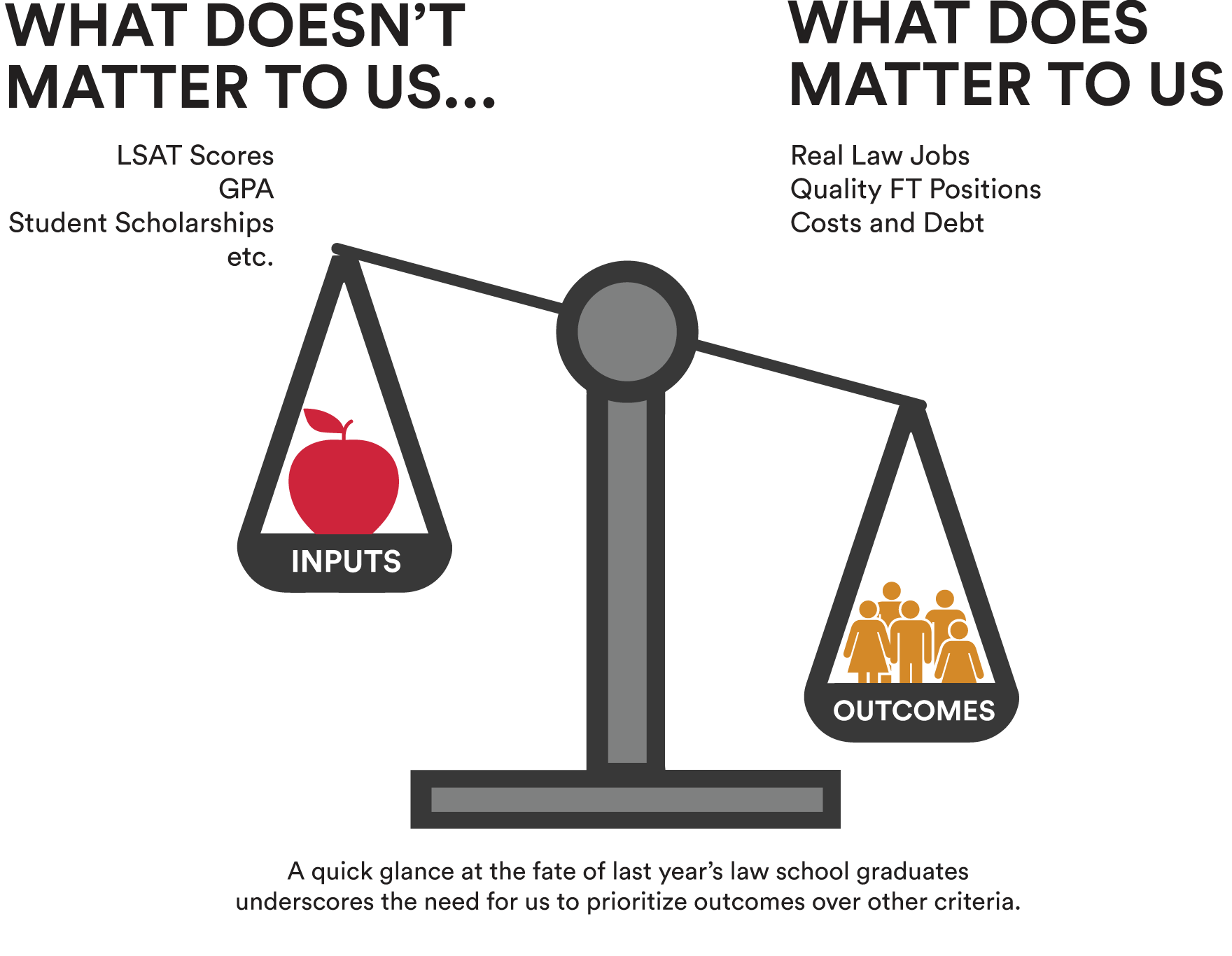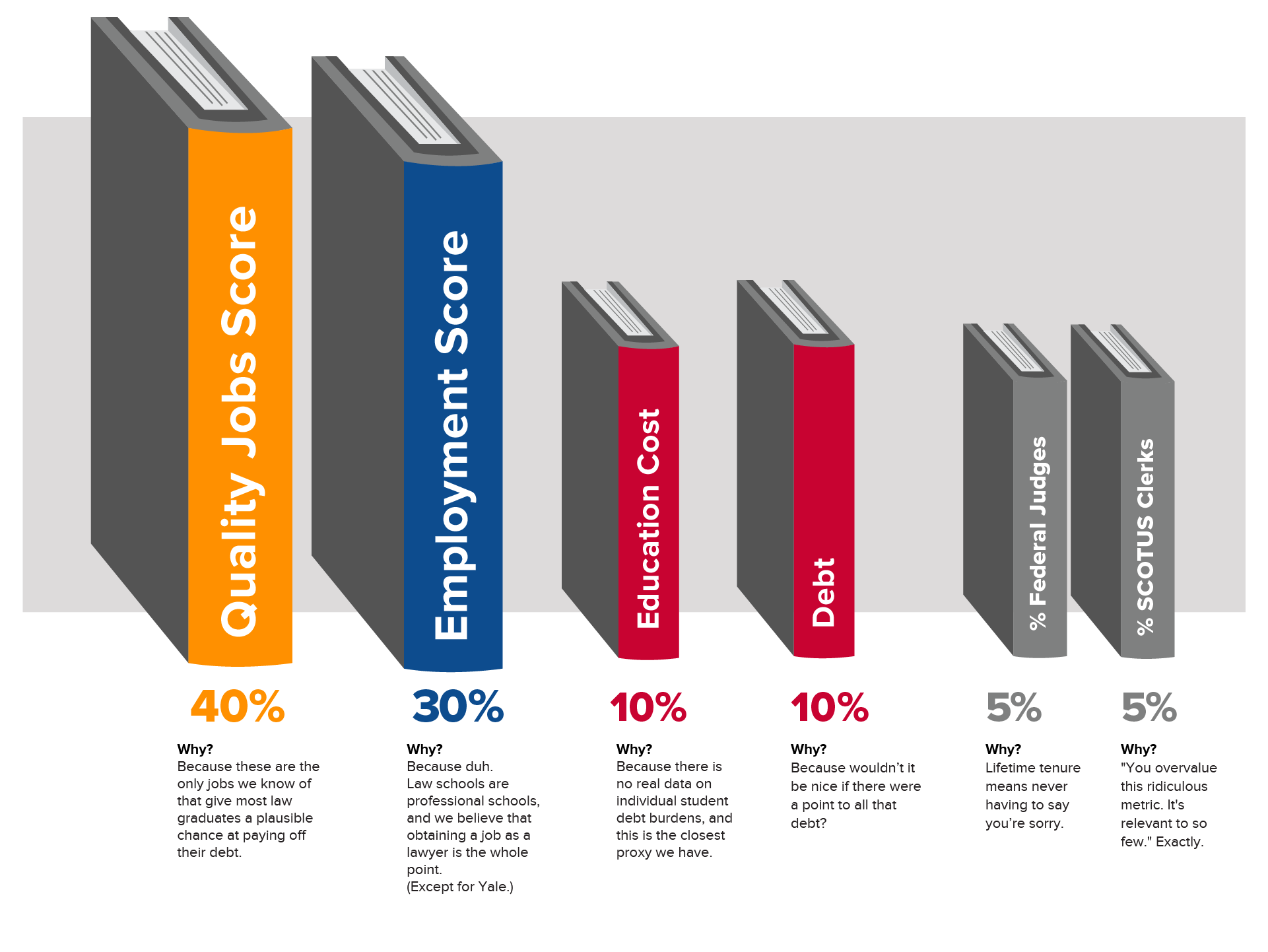Most people attend law school to obtain jobs as lawyers, or at least they should.
Law school student loans are real, and they are huge, so you’d best have a plan to pay them off on the back end of your J.D. The economic upheaval caused by the global pandemic has supercharged the need to focus on employment data as the number 1 factor in picking a law school, and ATL has your back on this one. Check out our list for the law schools most likely to see you gainfully employed. After all, if you want to go to law school, you’re probably going to want a job when it’s over.
Which law schools are putting their graduates in a position to get jobs? And which ones are leaving their students with little more than a diploma and a dream?
Welcome to the 11th annual installment of the Above the Law Top 50 Law School Rankings. These are the only rankings to incorporate the latest ABA employment data concerning the class of 2022. The premise underlying our approach to ranking schools remains the same: Given the steep cost of law school and the harsh realities of the legal job market—exacerbated by the continuing fallout from the global pandemic—potential students should prioritize their future employment prospects over all other factors in deciding whether and where to attend law school. The relative quality of schools is a function of how they deliver on the promise of gainful legal employment.
While we analyzed data for 120 schools, our ranking is limited to the top 50. We want to focus on “national” schools, the ones with quality employment prospects both outside of their particular region and/or for graduates who don’t graduate at the top of the class.
The ATL Top 50 Law School Rankings prioritize the only thing that really matters: outcomes.
The Rankings
See the 2022 rankings →How do law schools fare when assessed using this outcomes-based methodology?
| 2023 Rank | School | 2022 Rank | Change | Score |
|---|---|---|---|---|
| 1 | Duke | 1 | 0 | 75.29 |
| 2 | Cornell | 3 | 1 | 74.87 |
| 3 | U Virginia | 2 | -1 | 74.76 |
| 4 | U Chicago | 4 | 0 | 74.31 |
| 5 | U Michigan - Ann Arbor | 7 | 2 | 70.61 |
| 6 | Columbia | 8 | 2 | 69.62 |
| 7 | Vanderbilt | 5 | -2 | 69.58 |
| 8 | Northwestern (Pritzker) | 9 | 1 | 69.09 |
| 9 | U Penn (Carey) | 10 | 1 | 68.4 |
| 10 | U Notre Dame | 14 | 4 | 67.15 |
| 11 | Washington U in St. Louis | 6 | -5 | 65.5 |
| 12 | NYU | 17 | 5 | 64.77 |
| 13 | U Texas at Austin | 11 | -2 | 64.16 |
| 14 | Harvard | 16 | 2 | 63.77 |
| 15 | U Georgia | 13 | -2 | 62.11 |
| 16 | Yale | 15 | -1 | 61.45 |
| 17 | USC | 18 | 1 | 60.38 |
| 18 | Washington and Lee | 26 | 8 | 60.01 |
| 19 | U Illinois | 19 | 0 | 59.78 |
| 20 | UC Berkeley | 12 | -8 | 59.38 |
| 21 | U Alabama | 39 | 18 | 59.2 |
| 22 | UCLA | 23 | 1 | 58.76 |
| 23 | Fordham | 28 | 5 | 57.05 |
| 24 | Georgetown | 32 | 8 | 56.44 |
| 25 | U Utah (Quinney) | 36 | 11 | 56.38 |
| 26 | Boston College | 25 | -1 | 56.32 |
| 27 | Stanford | 27 | 0 | 56.26 |
| 28 | U Iowa | 33 | 5 | 56.19 |
| 29 | UNC - Chapel Hill | 20 | -9 | 55.87 |
| 30 | Boston U | 34 | 4 | 55.75 |
| 31 | U Florida (Levin) | 24 | -7 | 55.52 |
| 32 | Emory | 29 | -3 | 55.44 |
| 33 | Howard | NR | N/A | 54.34 |
| 34 | U Minnesota | 31 | -3 | 53.81 |
| 35 | U Kansas | 30 | -5 | 53.75 |
| 36 | Wake Forest | 21 | -15 | 53.32 |
| 37 | U Kentucky | 37 | 0 | 52.45 |
| 38 | SMU (Dedman) | 40 | 2 | 52.27 |
| 39 | Indiana U - Bloomington (Maurer) | 41 | 2 | 52.19 |
| 40 | Ohio State (Moritz) | 38 | -2 | 52.17 |
| 41 | Florida State | 45 | 4 | 51.97 |
| 42 | Brigham Young | 22 | -20 | 51.11 |
| 43 | U Tennessee - Knoxville | 48 | 5 | 49.72 |
| 44 | Northeastern | NR | N/A | 48.95 |
| 45 | William and Mary | NR | N/A | 48.83 |
| 46 | UC Davis | NR | N/A | 48.46 |
| 47 | Villanova | 35 | -12 | 47.74 |
| 48 | Georgia State | NR | N/A | 47.19 |
| 49 | U Nevada, Las Vegas | NR | N/A | 47.07 |
| 50 | U Wisconsin - Madison | 49 | -1 | 46.85 |
Let's put it simply:

What happened last year?
The Class of 2022
Total Law Grads: 36,078
Methodology
We prioritize employment outcomes above all else in comparing law schools. Therefore, these are the components of our rankings methodology:

Some further notes on methodology
QUALITY JOBS SCORE (40%)
This measures the schools’ success at placing students on career paths that best enable them to pay off their student debts. We’ve combined placement with the country’s largest and best-paying law firms and the percentage of graduates embarking on federal judicial clerkships. These clerkships typically lead to a broader and enhanced range of employment opportunities. (Employment data from the American Bar Association.)
EMPLOYMENT SCORE (30%)
We only counted full-time, long-term jobs requiring bar passage (excluding solos and school-funded positions). Look, we know that there are some great non-lawyer jobs out there for which a J.D. is an “advantage.” It’s not as if these jobs don’t count, it’s that they can’t be compared in a meaningful way. The definition of “J.D. Advantage” changes from year to year and is based on a self-reported metric that defies independent third-party verification. One school’s apples are another school’s oranges, but we’re not going to count lemons. (Some data courtesy of Law School Transparency.)
EDUCATION COST (10%)
The cost of a law school education matters not only to those students who take out loans to fund it, but also to those lucky enough to be able to pay for it outright. After all, law school is a major investment and how you view the return on that investment depends not only on the outcome (i.e., employment) but on how much you laid out to get there. And, because where you attend school plays a part in those expenses (e.g., three years living in New York City will leave a bigger hole in your bank account than three years in Lawrence, Kansas), we’ve also factored regional adjustments for cost of living into our scores for total cost. (Data on education cost courtesy of Law School Transparency.)
DEBT PER GRADUATE (10%)
Solid data on individual law student educational debt is hard to come by. Published averages exist, but the crucial number, the amount of non-dischargeable, government-funded or guaranteed educational loan debt, is not available. This figure represents a three-year average of the average amount of debt (i.e., amount borrowed) per graduate. (Data on average loan disbursement courtesy of Law School Transparency.)
SCOTUS CLERK & FEDERAL JUDGESHIP SCORES (5% EACH)
Though obviously applicable to very different stages of legal careers, these two categories represent the pinnacles of the profession. For the purposes of these rankings, we simply looked at a school’s graduates as a percentage of (1) all U.S. Supreme Court clerks (since 2018) and (2) currently sitting Article III judges. Both scores are adjusted for the size of the school. Obviously, we are aware that for the vast majority of students, Supreme Court clerkships or the federal bench are simply not prospects. But for the students who do want to be judges and academics, this outcome represents a useful separating factor for the most elite schools. Some schools put you in robes, others can’t.
